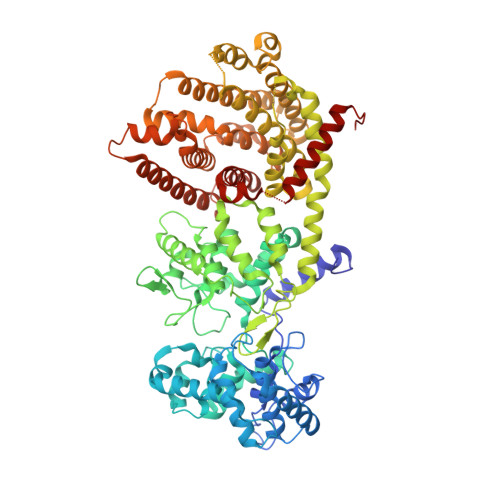Structural and mechanistic insights into the precise product synthesis by a bifunctional miltiradiene synthase.
Tong, Y., Ma, X., Hu, T., Chen, K., Cui, G., Su, P., Xu, H., Gao, W., Jiang, T., Huang, L.(2023) Plant Biotechnol J 21: 165-175
- PubMed: 36161753
- DOI: https://doi.org/10.1111/pbi.13933
- Primary Citation of Related Structures:
7WAT, 7Y47 - PubMed Abstract:
Selaginella moellendorffii miltiradiene synthase (SmMDS) is a unique bifunctional diterpene synthase (diTPS) that catalyses the successive cyclization of (E,E,E)-geranylgeranyl diphosphate (GGPP) via (+)-copalyl diphosphate (CPP) to miltiradiene, which is a crucial precursor of important medicinal compounds, such as triptolide, ecabet sodium and carnosol. Miltiradiene synthetic processes have been studied in monofunctional diTPSs, while the precise mechanism by which active site amino acids determine product simplicity and the experimental evidence for reaction intermediates remain elusive. In addition, how bifunctional diTPSs work compared to monofunctional enzymes is attractive for detailed research. Here, by mutagenesis studies of SmMDS, we confirmed that pimar-15-en-8-yl + is an intermediate in miltiradiene synthesis. Moreover, we determined the apo-state and the GGPP-bound state crystal structures of SmMDS. By structure analysis and mutagenesis experiments, possible contributions of key residues both in class I and II active sites were suggested. Based on the structural and functional analyses, we confirmed the copal-15-yl + intermediate and unveiled more details of the catalysis process in the SmMDS class I active site. Moreover, the structural and experimental results suggest an internal channel for (+)-CPP produced in the class II active site moving towards the class I active site. Our research is a good example for intermediate identification of diTPSs and provides new insights into the product specificity determinants and intermediate transport, which should greatly facilitate the precise controlled synthesis of various diterpenes.
- National Resource Center for Chinese Materia Medica, China Academy of Chinese Medical Sciences, Beijing, China.
Organizational Affiliation:


















